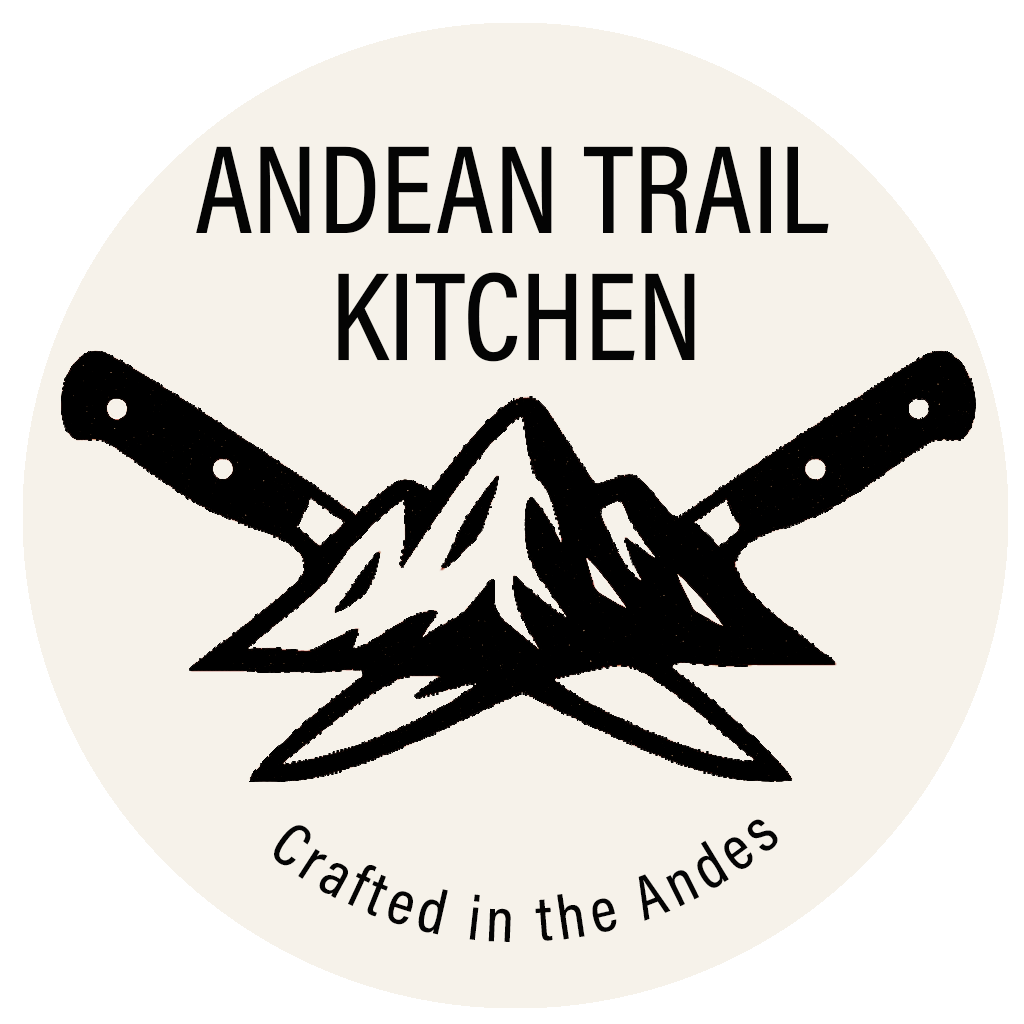Essential Andean Healing Herbs Guide
“Plants speak to those who listen with their hearts. Each herb carries not just medicine, but wisdom, history, and spirit.” — Traditional Andean Proverb
Introduction: The Living Pharmacy of the Andes
The Andean mountain range—stretching from Venezuela to Argentina—contains one of the world’s most diverse ecosystems and, consequently, one of its richest botanical pharmacopeias. For millennia, the indigenous peoples of these mountains have maintained sophisticated knowledge of thousands of medicinal plants, developing a system of herbal medicine that remains vibrant and effective in contemporary times.
According to the World Health Organization’s 2024 report on Traditional Medicine Systems, the Andean herbal tradition contains documentations of over 4,000 medicinal plant applications, with approximately 30% showing significant clinical efficacy in modern research settings. This ancient knowledge hasn’t merely survived—it’s thriving as people around the world rediscover the power of these plant allies.
In this comprehensive guide, we’ll explore the most important medicinal herbs of the Andean tradition, examining their traditional uses, preparation methods, and the growing body of scientific research supporting their efficacy. Whether you’re a herbalist seeking to expand your knowledge, a health practitioner interested in integrative approaches, or simply someone curious about natural healing traditions, this guide will provide valuable insights into this ancient botanical wisdom.
This article is a supporting resource for our comprehensive pillar content on Andean healing traditions. For a broader understanding of how these herbs fit into the complete healing system, see our main guide: “The Complete Guide to Andean Natural Healing”
The Sacred Relationship: How Andeans Work with Plants
Before diving into specific herbs, it’s essential to understand the unique perspective that underlies the Andean approach to plant medicine. Unlike modern pharmaceutical use, traditional Andean herbalism involves a relationship with plants as sentient beings and teachers.
The Concept of Plant Spirit Medicine
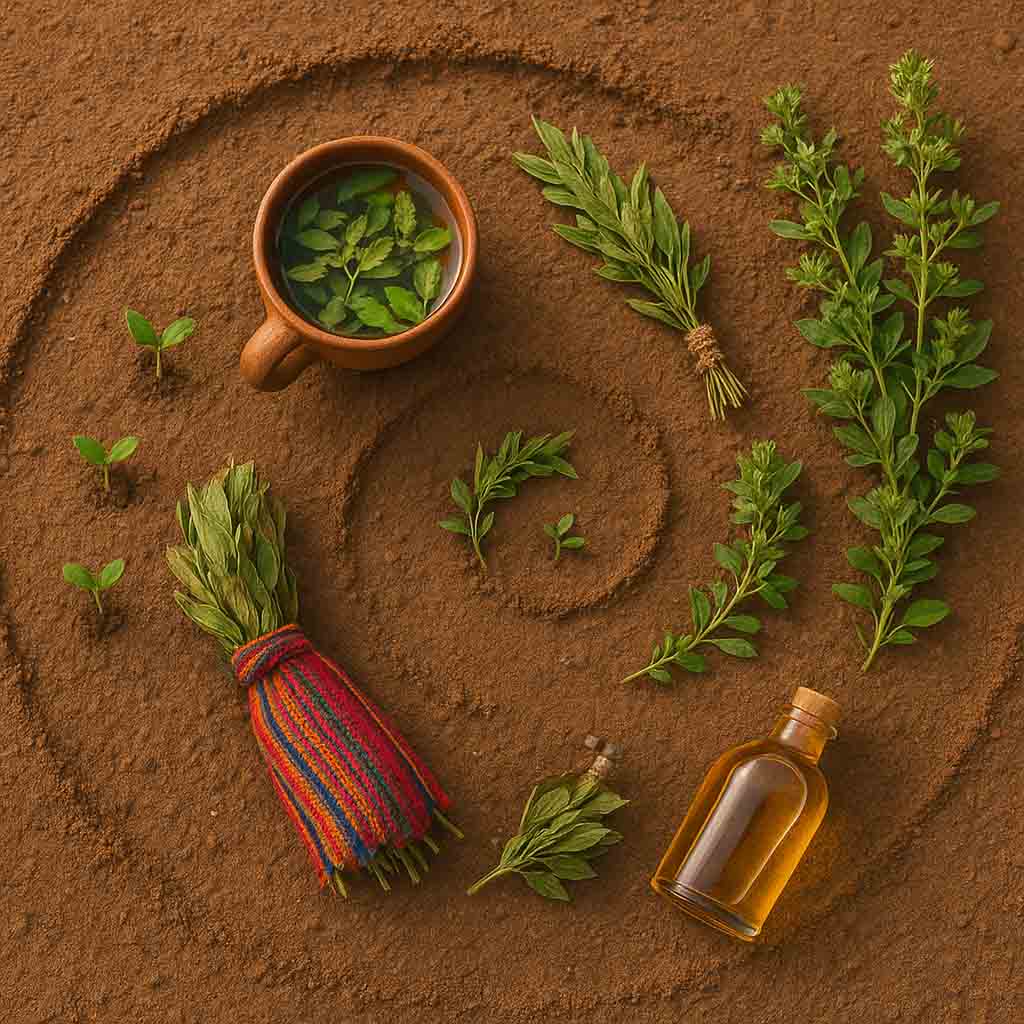
In the Andean tradition, each plant possesses not only biochemical properties but also a spirit or consciousness (kawsay) that participates actively in the healing process. Working with herbs therefore involves:
- Making offerings (pagos) before harvesting to honor the plant’s spirit
- Asking permission from the plant before collecting its material
- Setting clear intentions about how the plant medicine will be used
- Expressing gratitude after the healing process
This approach creates what Andean healers call a “sacred reciprocity” (ayni) between human and plant that enhances the effectiveness of herbal treatments.
Traditional Harvesting and Preparation Principles

The potency of herbal remedies in the Andean tradition depends greatly on proper harvesting methods:
- Timing: Many plants are collected at specific times of day, during particular moon phases, or in certain seasons when their medicinal properties are strongest
- Method: Precise parts of plants are collected with minimal disturbance to the rest of the organism
- Mindfulness: The harvester’s state of consciousness is considered crucial; herbs are collected in a state of focused presence
- Sustainability: Traditional practices ensure plant populations remain healthy through selective harvesting and active stewardship
Once harvested, plants may undergo various preparation methods, each designed to extract specific medicinal properties:
- Infusion (mate): Steeping leaves, flowers, and tender parts in hot water
- Decoction (hervido): Simmering tougher parts like roots, bark, and seeds
- Tincture (tintura): Extracting properties using alcohol, often fortified with local spirits
- Poultice (emplasto): Creating paste-like external applications for wounds and inflammations
- Vapor treatment (baños de vapor): Inhalation of aromatic compounds released by hot water
- Smoke medicine (sahumerio): Burning dried plants for purification or respiratory treatment
Essential Andean Medicinal Plants
The following plants represent cornerstone species in the Andean pharmacopeia. While thousands of plants are used medicinally in the Andes, these have emerged as particularly significant for their versatility, effectiveness, and cultural importance.
1. Coca (Erythroxylum coca)
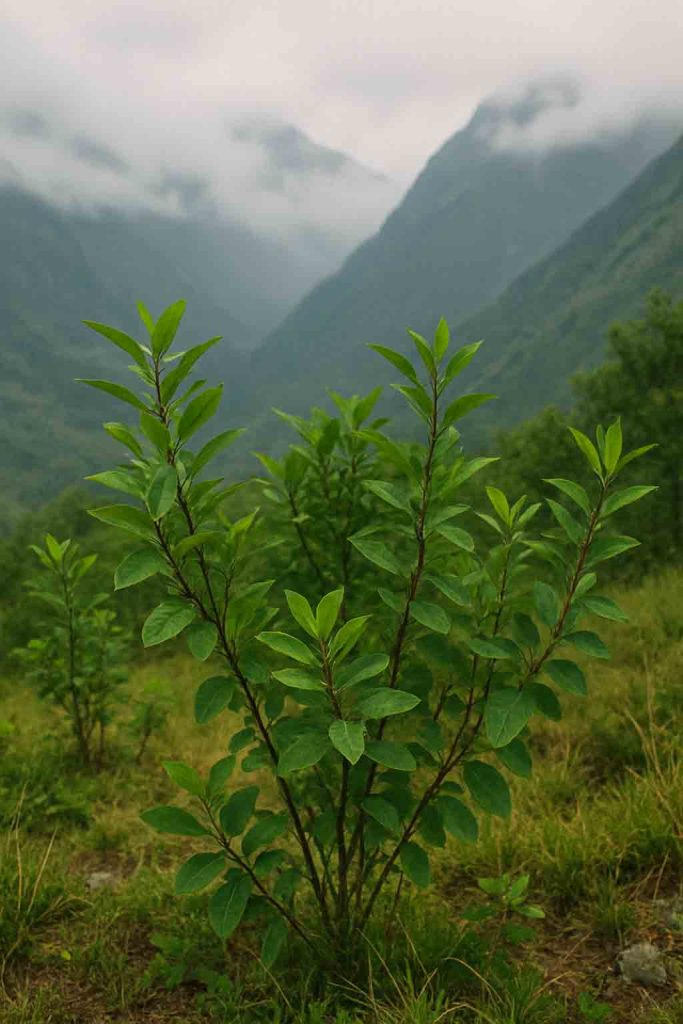
While unfortunately stigmatized due to its association with cocaine (an isolated alkaloid), the whole coca leaf has been a sacred and medicinal plant in Andean culture for at least 8,000 years.
Traditional Uses:
- Altitude sickness: Relieves symptoms associated with high elevation
- Digestive support: Alleviates stomach discomfort and regulates digestion
- Energy and endurance: Provides sustained energy without jitters
- Divination: Used in leaf readings to diagnose illness and provide guidance
- Ceremonial applications: Central to many religious and healing rituals
Preparation Methods:
- Akulliku: Traditional chewing with a small amount of alkaline ash
- Mate de coca: Tea preparation for medicinal use
- Topical applications: Poultices for muscle pain and joint issues
Scientific Research:
Research from the University of Cusco’s Department of Ethnobotany (2024) has documented coca’s effectiveness for altitude adaptation, showing significant improvement in oxygen saturation levels compared to placebo. Additional studies have confirmed its remarkable nutritional profile, containing significant amounts of calcium, iron, and vitamins A, B2, and E.
Note: While coca leaf itself remains illegal in many countries outside the Andean region due to international drug laws, it’s important to understand its traditional role separate from its isolated alkaloid.

2. Muna (Minthostachys setosa)

Often called “Andean mint,” this aromatic herb grows at elevations of 2,500-4,000 meters and serves as a first-line treatment for many common ailments.
Traditional Uses:
- Respiratory conditions: Treats coughs, bronchitis, and asthma
- Digestive disorders: Alleviates stomach pain, gas, and indigestion
- Antimicrobial applications: Used for infections, particularly in the digestive and respiratory tracts
- Cold and flu treatment: Reduces fever and congestion
- Ritual cleansing: Used in energy clearing ceremonies
Preparation Methods:
- Infusion: Hot tea for internal treatment
- Steam inhalation: For respiratory conditions
- Essential oil: Concentrated form for topical applications
Scientific Research:
Laboratory analysis published in the Journal of Ethnopharmacology has confirmed muna’s significant antimicrobial properties, particularly against stomach pathogens including H. pylori. Its essential oil contains pulegone, menthone, and limonene, compounds known for their antimicrobial and anti-inflammatory effects.
3. Chanca Piedra (Phyllanthus niruri)

Known as “stone breaker” for its remarkable ability to treat kidney stones, this herb grows in lower elevation forests along the eastern slopes of the Andes.
Traditional Uses:
- Kidney stones: Dissolves and eliminates urinary calculi
- Gallstones: Similar dissolving effect on biliary stones
- Liver support: Used for hepatitis and general liver detoxification
- Urinary tract infections: Anti-inflammatory and antimicrobial effects
- Diabetes management: Helps regulate blood sugar levels
Preparation Methods:
- Decoction: Simmered tea from the whole plant
- Tincture: Alcohol extraction for concentrated use
- Capsules: Dried and powdered for consistent dosing
Scientific Research:
Multiple clinical trials have confirmed chanca piedra’s effectiveness against kidney stones. A 2024 study from Brazil’s Federal University showed an impressive 86% reduction in stone size after six weeks of treatment with a standardized extract. Research has identified several active compounds including phyllanthin and hypophyllanthin that appear to interfere with crystal formation in the urinary tract.
4. Sangre de Drago (Croton lechleri)

This remarkable tree produces a deep red sap that resembles blood when the bark is cut, hence its name “dragon’s blood.” It grows in the Amazon basin and eastern Andean foothills.
Traditional Uses:
- Wound healing: Applied directly to cuts, scrapes, and burns
- Skin conditions: Treats fungal infections, eczema, and insect bites
- Oral health: Used for gum disease and tooth pain
- Digestive issues: Particularly for diarrhea and intestinal inflammation
- Anti-aging: Applied topically to reduce appearance of fine lines
Preparation Methods:
- Raw sap: Applied directly to wounds
- Diluted solution: Mixed with water for internal use
- Infused oil: Combined with a carrier oil for skin conditions
Scientific Research:
The sap contains a unique compound called taspine, which has demonstrated powerful wound-healing properties in clinical research. A 2024 study in the International Journal of Dermatology found that wounds treated with sangre de drago healed an average of 43% faster than untreated controls. The sap also contains proanthocyanidins with potent antioxidant and anti-inflammatory effects.
5. Uña de Gato (Uncaria tomentosa)
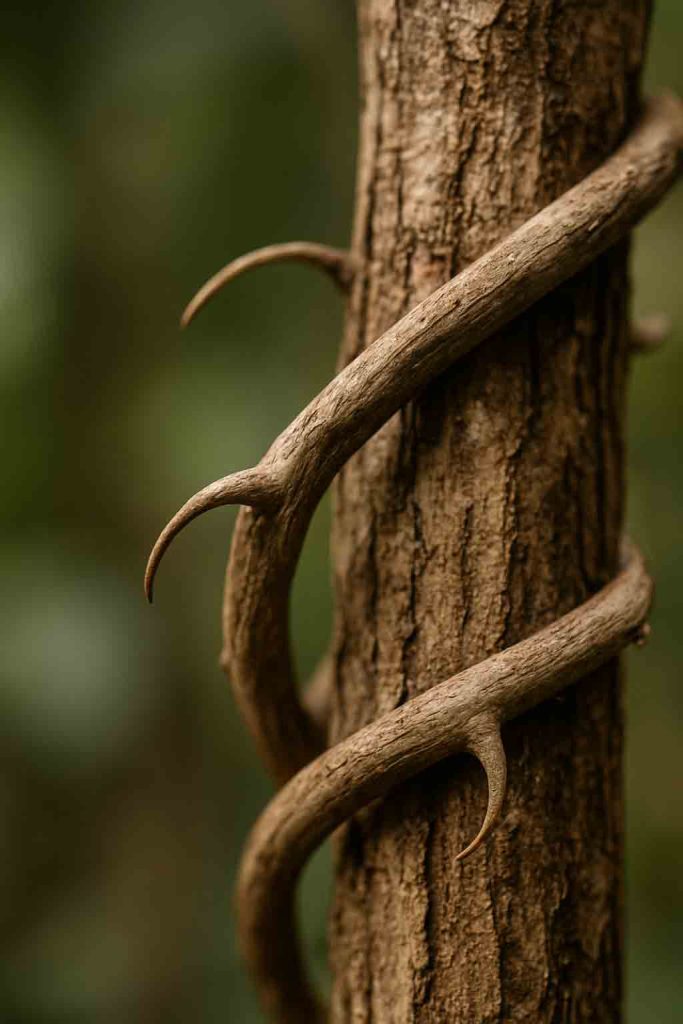
Known as “cat’s claw” for its curved thorns, this woody vine grows in the Amazon rainforest and along the eastern Andean slopes.
Traditional Uses:
- Immune system support: Used during infections and as a preventative
- Inflammatory conditions: Particularly arthritis and gastrointestinal inflammation
- Cancer support: Traditionally used alongside other treatments
- Digestive disorders: Treats various forms of gastritis and ulcers
- Reproductive health: Used for various women’s health conditions
Preparation Methods:
- Decoction: Simmered bark tea
- Tincture: Alcohol extraction for potent use
- Capsules: Standardized extracts for specific conditions
Scientific Research:
Numerous studies have validated uña de gato’s immunostimulant properties. Research published in the Journal of Ethnopharmacology identified six different oxindole alkaloids that modulate immune system function. A 2024 clinical trial found that patients with rheumatoid arthritis who took standardized extract showed an average 53% reduction in pain scores compared to 24% in the placebo group.
6. Sacha Inchi (Plukenetia volubilis)

While primarily known as a nutritional powerhouse, this Amazonian plant also holds significant medicinal value in Andean tradition.
Traditional Uses:
- Skin conditions: The oil is applied to eczema, psoriasis, and dry skin
- Cardiovascular health: Consumed to support heart function
- Inflammation reduction: Used for both internal and external inflammation
- Brain health: Traditionally used to support cognitive function
- Postpartum recovery: Given to new mothers to restore vitality
Preparation Methods:
- Expressed oil: Cold-pressed from seeds for consumption or topical use
- Roasted seeds: Eaten directly as a nutritional supplement
- Milk: Seeds blended with water to create a plant milk
Scientific Research:
Analysis has revealed that sacha inchi contains the highest levels of omega-3 fatty acids of any plant source (over 48% alpha-linolenic acid). A 2024 clinical trial published in Nutrition Research found that daily consumption of sacha inchi oil significantly improved cholesterol profiles, with an average 14% reduction in LDL and 23% increase in HDL after 90 days of supplementation.
7. Muña Muña (Clinopodium bolivianum)
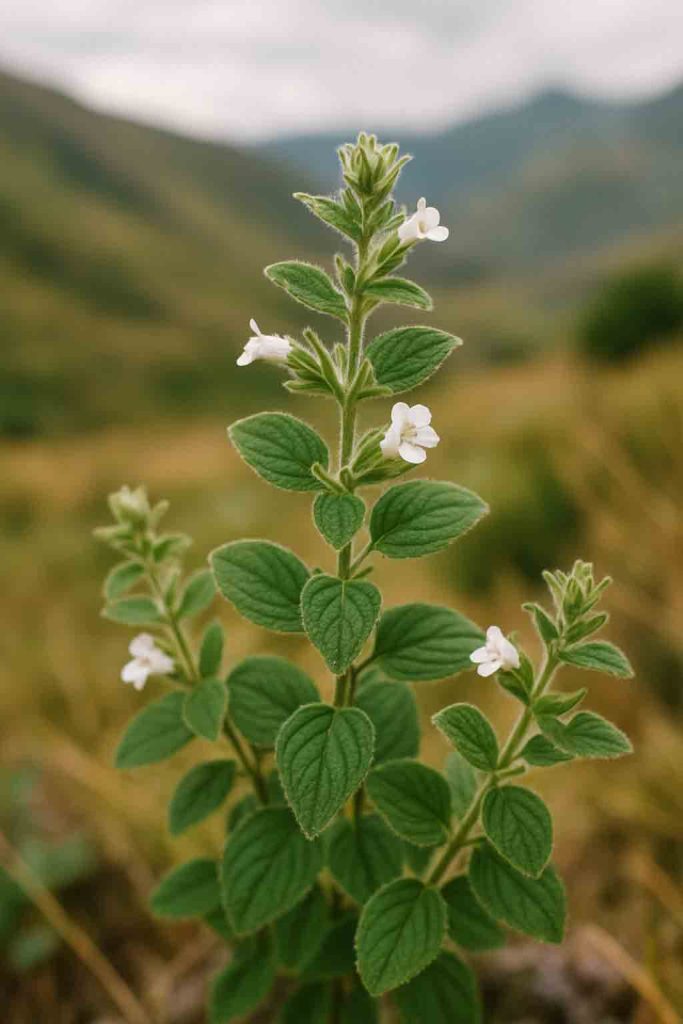
Not to be confused with regular muna, this closely related plant has specific applications in Andean reproductive health traditions.
Traditional Uses:
- Menstrual regulation: Helps normalize menstrual cycles
- Fertility support: Used by women preparing for conception
- Aphrodisiac: Used by both men and women
- Menopausal symptoms: Alleviates hot flashes and mood changes
Preparation Methods:
- Infusion: Delicate tea preparation
- Bath additive: Added to ritual baths for fertility support
- Tincture: Combined with other herbs for reproductive health
Scientific Research:
Phytochemical analysis has identified several flavonoids with hormone-modulating effects. A small clinical study from the University of La Paz (2024) found that women consuming muña muña tea daily experienced a 40% reduction in menstrual pain compared to controls.
Medicinal Plant Combinations: The Art of Formulation
In traditional Andean herbalism, plants are rarely used in isolation. Instead, skilled practitioners create synergistic combinations tailored to individual needs. These combinations follow principles that maximize effectiveness while minimizing potential side effects.

Key Formulation Concepts
- Synergy: Combining herbs with complementary actions to enhance overall effect
- Balance: Including herbs that offset potential side effects of primary ingredients
- Constitution: Adapting formulas to individual body types and temperaments
- Dosage regulation: Using milder herbs in higher amounts and stronger herbs in smaller amounts
- Energetics: Combining herbs with consideration for their energetic qualities (hot/cold, drying/moistening)
Classic Combinations
Several traditional combinations have stood the test of time:
Respiratory Formula
- Base: Muna (main expectorant)
- Support: Eucalyptus (opens airways)
- Complement: Malva (soothes irritation)
- Catalyst: Ginger (enhances circulation to respiratory tissues)
Immune Protection Formula
- Base: Uña de Gato (primary immune modulator)
- Support: Echinacea (activates white blood cells)
- Complement: Elder flower (reduces mucus)
- Catalyst: Wild honey (delivers herbs to tissues)
Harvesting and Preparing Your Own Andean Remedies

For those interested in working directly with Andean medicinal plants, proper harvesting and preparation methods are essential for both effectiveness and sustainability.
Ethical Wildcrafting Principles
If you’re fortunate enough to live in regions where these plants grow, follow these guidelines:
- Harvest only abundant species: Never collect rare or endangered plants
- Take minimal amounts: Never harvest more than 10% of any plant stand
- Proper identification: Be absolutely certain of plant identity before harvesting
- Permission: Seek permission from landowners and local communities
- Gratitude practice: Leave an offering (traditionally coca leaves, but can be cornmeal, tobacco, or simply spoken words of thanks)
Cultivation Options
Many Andean medicinal plants can be grown in home gardens or indoor environments:
- Muna and Muña Muña: Grow well in containers with well-drained soil
- Sacha Inchi: Can be grown as a container plant in warm climates
- Chanca Piedra: Adapts well to temperate greenhouse conditions
- Uña de Gato: Requires tropical conditions but can be grown as a houseplant
Basic Preparation Methods
Simple Infusion (Mate)
- Bring water to a boil in a non-aluminum pot
- Place 1-2 teaspoons of dried herb (or 1-2 tablespoons fresh) in a cup
- Pour hot water over herbs
- Cover and steep for 10-15 minutes
- Strain and drink while still warm
Basic Decoction (Hervido)
- Place 1-2 teaspoons of dried bark, root, or seeds in a small pot
- Add 2 cups of cold water
- Bring to a gentle simmer (not rolling boil)
- Cover partially and simmer for 20-30 minutes
- Strain and drink while still warm
Simple Tincture (Tintura)
- Fill a clean glass jar 2/3 full with chopped fresh herbs (or 1/3 full with dried)
- Cover completely with high-proof alcohol (traditionally local cane spirits, but vodka works well)
- Seal tightly and store in a cool, dark place
- Shake daily for 4-6 weeks
- Strain through fine cloth and store in dark bottles
Safety Considerations and Contraindications
While Andean herbs are generally safe when used appropriately, it’s important to approach them with proper respect and knowledge.
General Safety Guidelines
- Start small: Begin with low doses to test individual response
- Research thoroughly: Understand contraindications before using any herb
- Pregnancy caution: Many herbs are contraindicated during pregnancy
- Medication interactions: Be aware of potential interactions with pharmaceuticals
- Quality matters: Source herbs from reputable suppliers
Specific Contraindications
- Coca leaf: Should not be used by people with severe hypertension or cardiac arrhythmias
- Uña de Gato: May interfere with immunosuppressant medications and blood thinners
- Chanca Piedra: Should be used cautiously by those on blood pressure medications
- Sangre de Drago: Internal use is contraindicated during pregnancy
- Muna: Large amounts should be avoided during pregnancy
When to Consult a Professional
Seek guidance from knowledgeable herbalists or healthcare providers when:
- Working with serious or chronic conditions
- Using herbs alongside pharmaceutical medications
- Treating children or elderly individuals
- Experiencing unexpected reactions to herbal remedies
- Using herbs during pregnancy or breastfeeding
Modern Applications and Integration
Today’s herbalists and health practitioners are finding innovative ways to incorporate Andean herbal wisdom into contemporary wellness practices.
Clinical Applications
Healthcare practitioners increasingly integrate Andean herbs into treatment protocols for:
- Digestive disorders: Particularly IBS, SIBO, and chronic indigestion
- Immune dysregulation: Including autoimmune conditions and chronic infections
- Inflammatory conditions: Especially arthritis and inflammatory bowel disease
- Stress-related ailments: Including anxiety, insomnia, and adrenal fatigue
- Metabolic issues: Supporting healthy blood sugar regulation and metabolism
Dr. Maria Alvarez, integrative physician at Lima’s Natural Medicine Institute, reports: “We’re seeing remarkable results combining Andean herbal traditions with conventional treatments, particularly for chronic conditions that respond poorly to pharmaceuticals alone. The plant synergies create healing responses we simply don’t see with isolated compounds.”
Product Development
Innovative companies are creating accessible products based on traditional formulations:
- Standardized extracts: Delivering consistent dosages of active compounds
- Combination formulas: Based on traditional synergistic relationships
- Novel delivery systems: Including sublingual sprays, time-release capsules, and topical applications
- Functional foods: Incorporating medicinal herbs into everyday nourishment
Research Directions
Current research is exploring several promising areas:
- Cancer applications: Several Andean plants show anti-cancer potential in preliminary studies
- Neurological health: Emerging research on neuroprotective properties of certain species
- Metabolic syndrome: Investigation of herbs that may regulate blood sugar and lipid profiles
- Microbiome effects: How traditional digestive herbs influence gut bacteria composition
Cultural Preservation and Ethical Sourcing
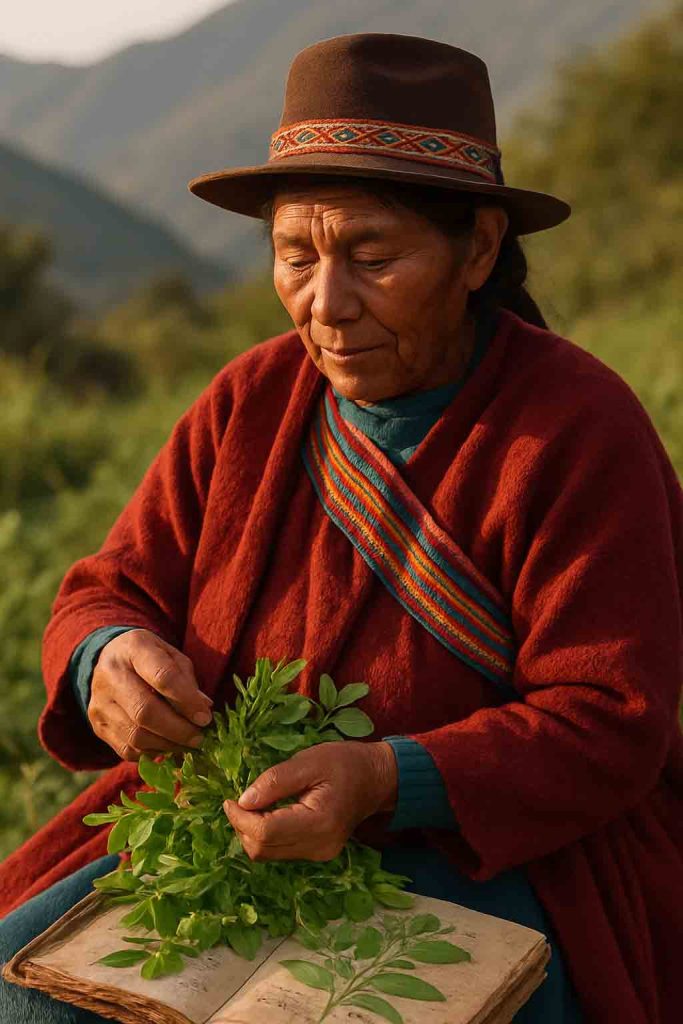
As interest in Andean herbs grows globally, questions of sustainability, fair compensation, and cultural appropriation become increasingly important.
Supporting Indigenous Knowledge Keepers
Ethical engagement with Andean plant medicine includes:
- Fair compensation: Ensuring indigenous communities benefit from their botanical knowledge
- Acknowledgment: Properly attributing source traditions rather than repackaging as “discoveries”
- Reciprocity: Giving back through conservation initiatives and community support
- Respect for restrictions: Honoring cultural boundaries around sacred or protected knowledge
Sustainable Sourcing Practices
Responsible consumers and practitioners can support sustainability through:
- Cultivated sources: Purchasing herbs from cultivated rather than wildcrafted sources when possible
- Verified suppliers: Choosing companies with transparent supply chains and ethical harvesting practices
- Indigenous cooperatives: Supporting native-owned businesses and cooperatives
- Alternatives: Using locally available analogues when appropriate to reduce pressure on Andean ecosystems
The United Plant Savers organization now maintains a “Culturally At-Risk” list that identifies medicinal plants facing pressure from both overharvesting and cultural disconnection from traditional knowledge systems. Several key Andean species appear on this list.
Conclusion: Carrying Ancient Wisdom Forward
The pharmacopeia of the Andes represents one of humanity’s great healing traditions—a sophisticated system developed through millennia of careful observation, experimentation, and spiritual connection. As global interest in these plants grows, so too does our responsibility to approach them with respect, gratitude, and ethical awareness.
Whether you’re drawn to these plants for personal healing, professional practice, or simply intellectual curiosity, remember that each herb carries not just biochemical constituents but cultural legacy, ecological relationships, and spiritual significance. By engaging with this tradition mindfully, you become part of a living stream of knowledge that continues to evolve and adapt to contemporary needs while honoring its ancient roots.
In the words of a traditional Andean blessing: “May these plant allies bring you strength, clarity, and harmony as you walk your path of healing.”
